Data Fusion-Based Musculoskeletal Synergies in the Grasping Hand
Abstract
1. Introduction
2. Methods and Analysis
2.1. Experiment
2.2. Preprocessing
2.3. Derivation of Synergies
- (i)
- Kinematic and Muscle Synergies
- (ii)
- Musculoskeletal Synergies
2.4. Reconstruction of Movement Kinematics and Muscle Activities Using l1-Norm Minimization
- (i)
- Kinematic and Muscle Synergies
- (ii)
- Musculoskeletal Synergies
3. Results
3.1. Extraction and Reconstruction Using Kinematic and Muscle Synergies
3.2. Independent Component Analysis (ICA)
4. Discussion
5. Conclusions
Author Contributions
Funding
Institutional Review Board Statement
Informed Consent Statement
Data Availability Statement
Acknowledgments
Conflicts of Interest
References
- Stuart, D.G. Integration of posture and movement: Contributions of Sherrington, Hess, and Bernstein. Hum. Mov. Sci. 2005, 24, 621–643. [Google Scholar] [CrossRef] [PubMed]
- Santello, M.; Flanders, M.; Soechting, J.F. Postural hand synergies for tool use. J. Neurosci. 1998, 18, 10105–10115. [Google Scholar] [CrossRef] [PubMed]
- Vinjamuri, R.; Sun, M.; Chang, C.-C.; Lee, H.-N.; Sclabassi, R.J.; Mao, Z.-H. Temporal postural synergies of the hand in rapid grasping tasks. IEEE Trans. Inf. Technol. Biomed. 2010, 14, 986–994. [Google Scholar] [CrossRef] [PubMed]
- Vinjamuri, R.; Sun, M.; Chang, C.; Lee, H.; Sclabassi, R.J. Dimensionality Reduction in Control and Coordination of the Human Hand. IEEE Trans. Biomed. Eng. 2010, 57, 284–295. [Google Scholar] [CrossRef]
- Pei, D.; Olikkal, P.; Adali, T.; Vinjamuri, R. Dynamical Synergies of Multidigit Hand Prehension. Sensors 2022, 22, 4177. [Google Scholar] [CrossRef]
- Weiss, E.J.; Flanders, M. Muscular and postural synergies of the human hand. J. Neurophysiol. 2004, 92, 523–535. [Google Scholar] [CrossRef]
- d’Avella, A.; Portone, A.; Lacquaniti, F. Superposition and modulation of muscle synergies for reaching in response to a change in target location. J. Neurophysiol. 2011, 106, 2796–2812. [Google Scholar] [CrossRef]
- Santello, M.; Baud-Bovy, G.; Jörntell, H. Neural bases of hand synergies. Front. Comput. Neurosci. 2013, 7, 23. [Google Scholar] [CrossRef]
- Leo, A.; Handjaras, G.; Bianchi, M.; Marino, H.; Gabiccini, M.; Guidi, A.; Scilingo, E.P.; Pietrini, P.; Bicchi, A.; Santello, M.; et al. A synergy-based hand control is encoded in human motor cortical areas. Elife 2016, 5, e13420. [Google Scholar] [CrossRef]
- Pei, D.; Patel, V.; Burns, M.; Chandramouli, R.; Vinjamuri, R. Neural Decoding of Synergy-Based Hand Movements Using Electroencephalography. IEEE Access 2019, 7, 18155–18163. [Google Scholar] [CrossRef]
- Pei, D.; Olikkal, P.; Adali, T.; Vinjamuri, R. Reconstructing Synergy-Based Hand Grasp Kinematics from Electroencephalographic Signals. Sensors 2022, 22, 5349. [Google Scholar] [CrossRef]
- Jarque-Bou, N.J.; Vergara, M.; Sancho-Bru, J.L.; Gracia-Ibáñez, V.; Roda-Sales, A. A calibrated database of kinematics and EMG of the forearm and hand during activities of daily living. Sci. Data 2019, 6, 1–11. [Google Scholar] [CrossRef]
- Gracia-Ibáñez, V.; Vergara, M.; Buffi, J.H.; Murray, W.M.; Sancho-Bru, J.L. Across-subject calibration of an instrumented glove to measure hand movement for clinical purposes. Comput. Methods Biomech. Biomed. Engin. 2017, 20, 587–597. [Google Scholar] [CrossRef]
- Vinjamuri, R.; Sun, M.; Crammond, D.; Sclabassi, R.; Mao, Z.-H. Inherent bimanual postural synergies in hands. Annu. Int. Conf. IEEE Eng. Med. Biol. Soc. 2008, 2008, 5093–5096. [Google Scholar]
- Jollife, I.T.; Cadima, J. Principal component analysis: A review and recent developments. Philos. Trans. A Math. Phys. Eng. Sci. 2016, 374, 20150202. [Google Scholar] [CrossRef] [PubMed]
- Patel, V.; Thukral, P.; Burns, M.K.; Florescu, I.; Chandramouli, R.; Vinjamuri, R. Hand grasping synergies as biometrics. Front. Bioeng. Biotechnol. 2017, 5, 26. [Google Scholar] [CrossRef]
- Le, Q.; Karpenko, A.; Ngiam, J.; Ng, A. ICA with Reconstruction Cost for Efficient Overcomplete Feature Learning. In Proceedings of the Advances in Neural Information Processing Systems, Granada, Spain, 12–15 December 2011; Shawe-Taylor, J., Zemel, R., Bartlett, P., Pereira, F., Weinberger, K.Q., Eds.; Curran Associates, Inc.: Red Hook, NY, USA, 2011; Volume 24. [Google Scholar]
- Tanzarella, S.; Muceli, S.; Santello, M.; Farina, D. Synergistic organization of neural inputs from spinal motor neurons to extrinsic and intrinsic hand muscles. J. Neurosci. 2021, 41, 6878–6891. [Google Scholar] [CrossRef] [PubMed]
- Patel, V.; Burns, M.; Mao, Z.H.; Crone, N.E.; Vinjamuri, R. Linear and Nonlinear Kinematic Synergies in the Grasping Hand. J. Bioeng. Biomed. Sci. 2015, 5, 163. [Google Scholar] [CrossRef]
- Ajiboye, A.B.; Weir, R.F. Muscle synergies as a predictive framework for the EMG patterns of new hand postures. J. Neural Eng. 2009, 6, 036004. [Google Scholar] [CrossRef] [PubMed]
- Arnet, U.; Muzykewicz, D.A.; Fridén, J.; Lieber, R.L. Intrinsic hand muscle function I: Creating a functional grasp. J. Hand Surg. Am. 2013, 38, 2093–2099. [Google Scholar] [CrossRef][Green Version]
- Olikkal, P.; Pei, D.; Adali, T.; Banerjee, N.; Vinjamuri, R. Musculoskeletal Synergies in the Grasping Hand. Annu. Int. Conf. IEEE Eng. Med. Biol. Soc. 2022, 2022, 3649–3652. [Google Scholar] [PubMed]
- Tresch, M.C.; Cheung, V.C.K.; D’Avella, A. Matrix factorization algorithms for the identification of muscle synergies: Evaluation on simulated and experimental data sets. J. Neurophysiol. 2006, 95, 2199–2212. [Google Scholar] [CrossRef] [PubMed]
- Israely, S.; Leisman, G.; Machluf, C.C.; Carmeli, E. Muscle synergies control during hand-reaching tasks in multiple directions post-stroke. Front. Comput. Neurosci. 2018, 12, 10. [Google Scholar] [CrossRef] [PubMed]
- Günay, S.Y.; Quivira, F.; Erdogmu, D. Muscle Synergy-based Grasp Classification for Robotic Hand Prosthetics. Int. Conf. Pervasive Technol. Relat. Assist. Environ. 2017, 2017, 335–338. [Google Scholar]
- Shourijeh, M.S.; Flaxman, T.E.; Benoit, D.L. An approach for improving repeatability and reliability of non-negative matrix factorization for muscle synergy analysis. J. Electromyogr. Kinesiol. 2016, 26, 36–43. [Google Scholar] [CrossRef]
- Pei, D.; Adali, T.; Vinjamuri, R. Generalizability of Hand Kinematic Synergies derived using Independent Component Analysis. Annu. Int. Conf. IEEE Eng. Med. Biol. Soc. 2021, 2021, 621–624. [Google Scholar]
- Vinjamuri, R.; Patel, V.; Powell, M.; Mao, Z.H.; Crone, N. Candidates for synergies: Linear Discriminants versus principal components. Comput. Intell. Neurosci. 2014, 2014, 373957. [Google Scholar] [CrossRef]
- Scano, A.; Mira, R.M.; d’Avella, A. Mixed matrix factorization: A novel algorithm for the extraction of kinematic-muscular synergies. J. Neurophysiol. 2022, 127, 529–547. [Google Scholar] [CrossRef]
- Adali, T.; Anderson, M.; Fu, G.S. Diversity in independent component and vector analyses: Identifiability, algorithms, and applications in medical imaging. IEEE Signal Process. Mag. 2014, 31, 18–33. [Google Scholar] [CrossRef]
- Adali, T.; Levin-Schwartz, Y.; Calhoun, V.D. Multimodal Data Fusion Using Source Separation: Application to Medical Imaging. Proc. IEEE 2015, 103, 1494–1506. [Google Scholar] [CrossRef]
- Adali, T.; Levin-Schwartz, Y.; Calhoun, V.D. Multimodal Data Fusion Using Source Separation: Two Effective Models Based on ICA and IVA and Their Properties. Proc. IEEE 2015, 103, 1478–1493. [Google Scholar] [CrossRef] [PubMed]
- Calhoun, V.D.; Adali, T.; Pearlson, G.D.; Kiehl, K.A. Neuronal chronometry of target detection: Fusion of hemodynamic and event-related potential data. Neuroimage 2006, 30, 544–553. [Google Scholar] [CrossRef] [PubMed]
- Kim, T.; Lee, I.; Lee, T.W. Independent vector analysis: Definition and algorithms. In Proceedings of the Conference Record—Asilomar Conference on Signals, Systems and Computers, Pacific Grove, CA, USA, 29 October–1 November 2006; pp. 1393–1396. [Google Scholar]
- Anderson, M.; Fu, G.S.; Phlypo, R.; Adali, T. Independent Vector Analysis: Identification Conditions and Performance Bounds. IEEE Trans. Signal Process. 2014, 62, 4399–4410. [Google Scholar] [CrossRef]
- von Lühmann, A.; Boukouvalas, Z.; Müller, K.R.; Adalı, T. A new blind source separation framework for signal analysis and artifact rejection in functional Near-Infrared Spectroscopy. Neuroimage 2019, 200, 72–88. [Google Scholar] [CrossRef]
- Emge, D.K.; Vialatte, F.B.; Dreyfus, G.; Adalı, T. Independent Vector Analysis for SSVEP Signal Enhancement, Detection, and Topographical Mapping. Brain Topogr. 2018, 31, 117–124. [Google Scholar] [CrossRef]
- Huang, B.; Xiong, C.; Chen, W.; Liang, J.; Sun, B.Y.; Gong, X. Common kinematic synergies of various human locomotor behaviours. R. Soc. Open Sci. 2021, 8, 210161. [Google Scholar] [CrossRef]
- Chen, W.; Xiao, Z.; Lu, J.; Zhao, Z.; Wang, Y. Design and Analysis of a Synergy-Inspired Three-Fingered Hand. In Proceedings of the 2020 IEEE International Conference on Robotics and Automation (ICRA), Paris, France, 31 May–31 August 2020; pp. 8942–8948. [Google Scholar]
- Amunts, K.; Knoll, A.C.; Lippert, T.; Pennartz, C.M.A.; Ryvlin, P.; Destexhe, A.; Jirsa, V.K.; D’Angelo, E.; Bjaalie, J.G. The Human Brain Project—Synergy between neuroscience, computing, informatics, and brain-inspired technologies. PLoS Biol. 2019, 17, e3000344. [Google Scholar] [CrossRef]
- Alicea, R.; Xiloyannis, M.; Chiaradia, D.; Barsotti, M.; Frisoli, A.; Masia, L. A soft, synergy-based robotic glove for grasping assistance. Wearable Technol. 2021, 2, e4. [Google Scholar] [CrossRef]
- Hong, Y.N.G.; Ballekere, A.N.; Fregly, B.J.; Roh, J. Are muscle synergies useful for stroke rehabilitation? Curr. Opin. Biomed. Eng. 2021, 19, 100315. [Google Scholar] [CrossRef]
- Matsuura, Y.; Matsunaga, N.; Iizuka, S.; Akuzawa, H.; Kaneoka, K. Muscle Synergy of the Underwater Undulatory Swimming in Elite Male Swimmers. Front. Sport. Act. Living 2020, 2, 62. [Google Scholar] [CrossRef]
- Esmaeili, J.; Maleki, A. Muscle coordination analysis by time-varying muscle synergy extraction during cycling across various mechanical conditions. Biocybern. Biomed. Eng. 2020, 40, 90–99. [Google Scholar] [CrossRef]
- Umehara, J.; Yagi, M.; Hirono, T.; Ueda, Y.; Ichihashi, N. Quantification of muscle coordination underlying basic shoulder movements using muscle synergy extraction. J. Biomech. 2021, 120, 110358. [Google Scholar] [CrossRef] [PubMed]
- Severini, G.; Koenig, A.; Adans-Dester, C.; Cajigas, I.; Cheung, V.C.K.; Bonato, P. Robot-Driven Locomotor Perturbations Reveal Synergy-Mediated, Context-Dependent Feedforward and Feedback Mechanisms of Adaptation. Sci. Rep. 2020, 10, 1–16. [Google Scholar] [CrossRef] [PubMed]
- Wang, C.; Peng, L.; Hou, Z.G.; Li, J.; Zhang, T.; Zhao, J. Quantitative Assessment of Upper-Limb Motor Function for Post-Stroke Rehabilitation Based on Motor Synergy Analysis and Multi-Modality Fusion. IEEE Trans. Neural Syst. Rehabil. Eng. 2020, 28, 943–952. [Google Scholar] [CrossRef] [PubMed]
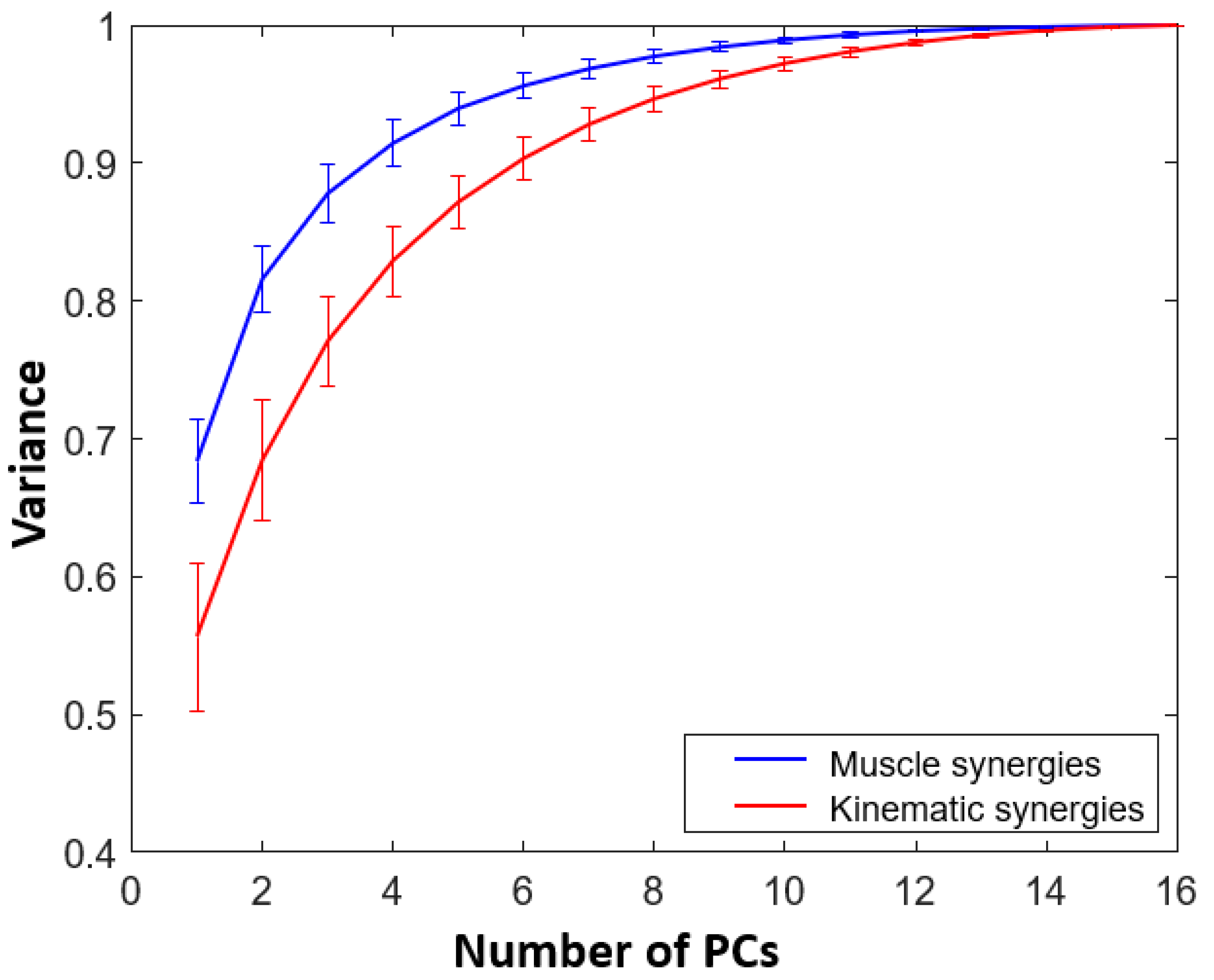
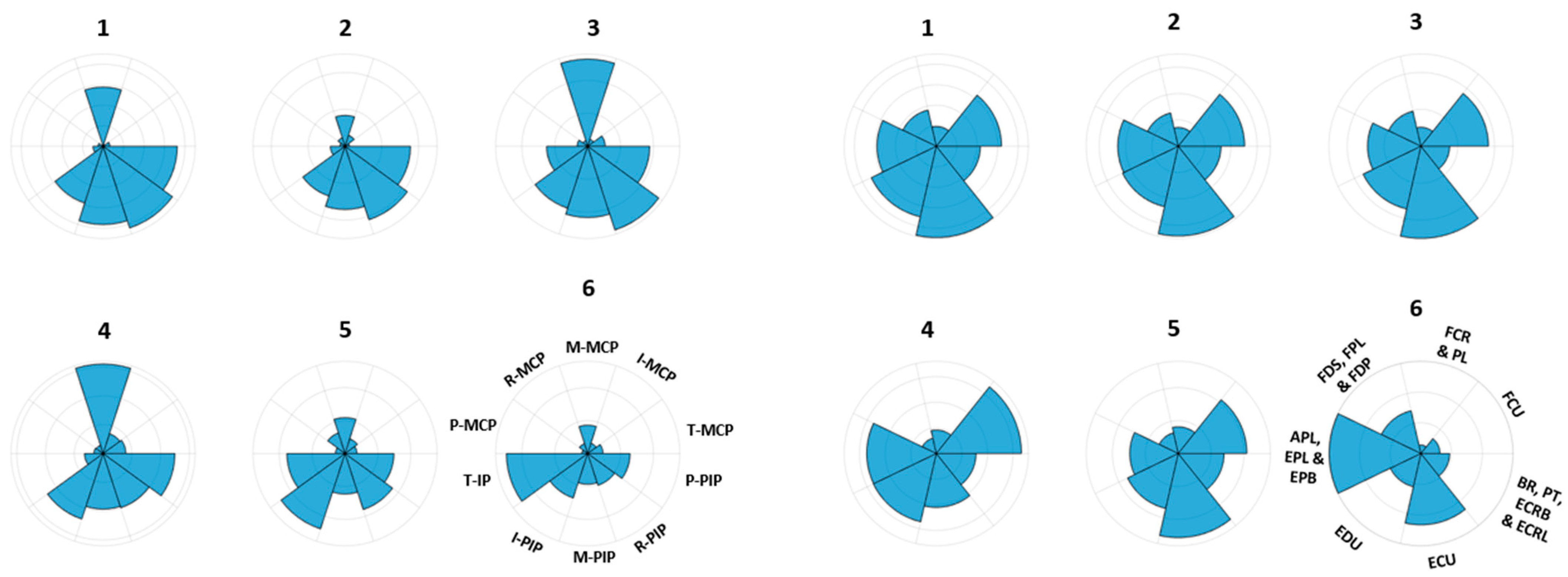
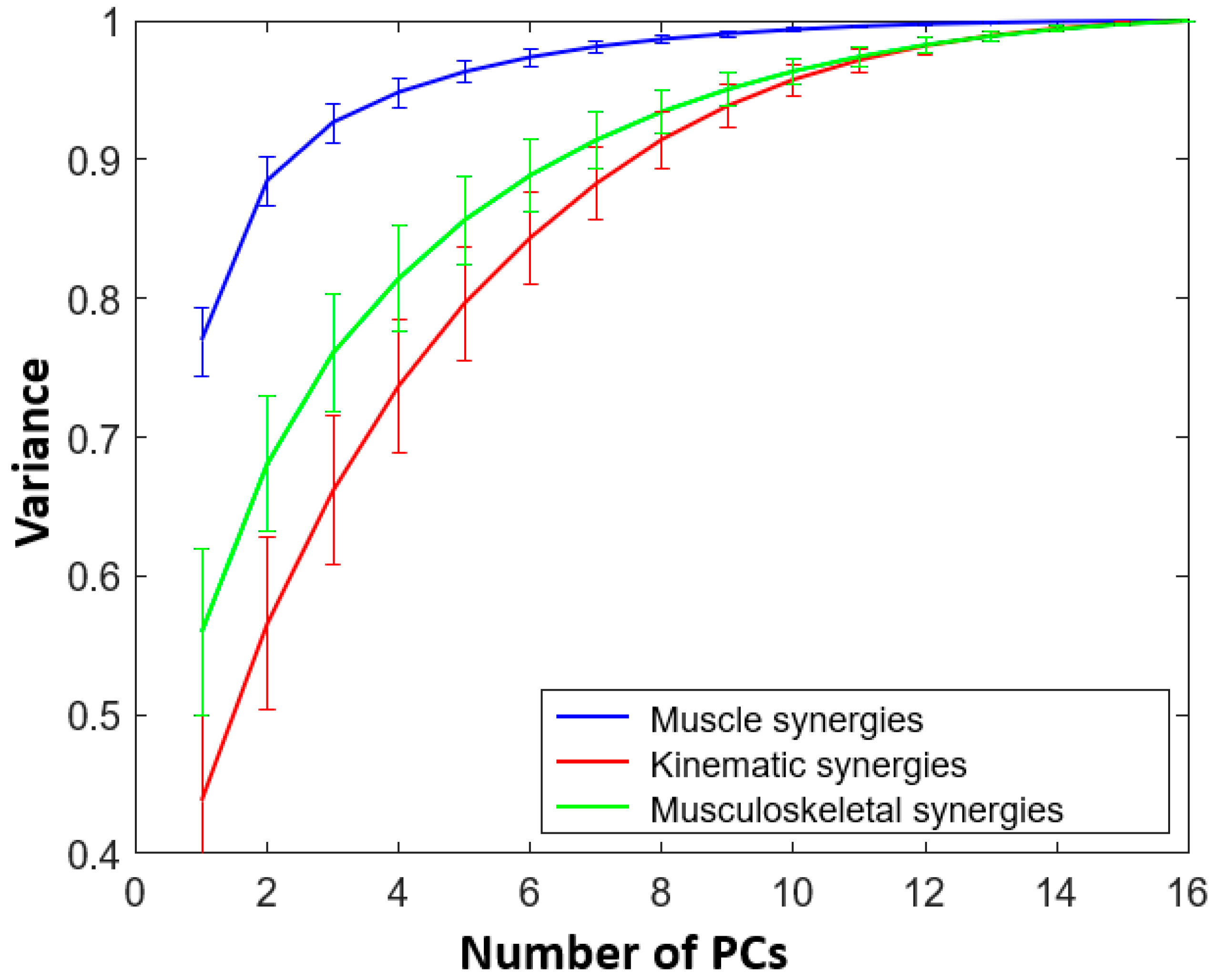
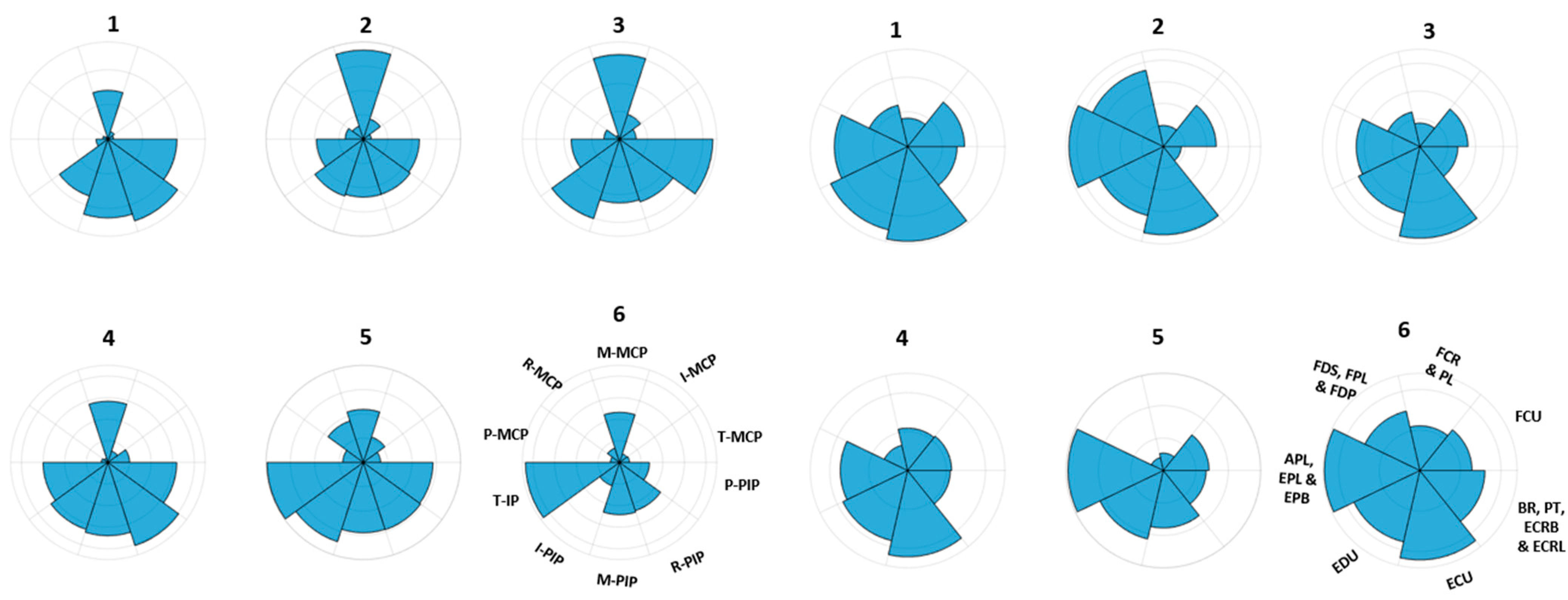

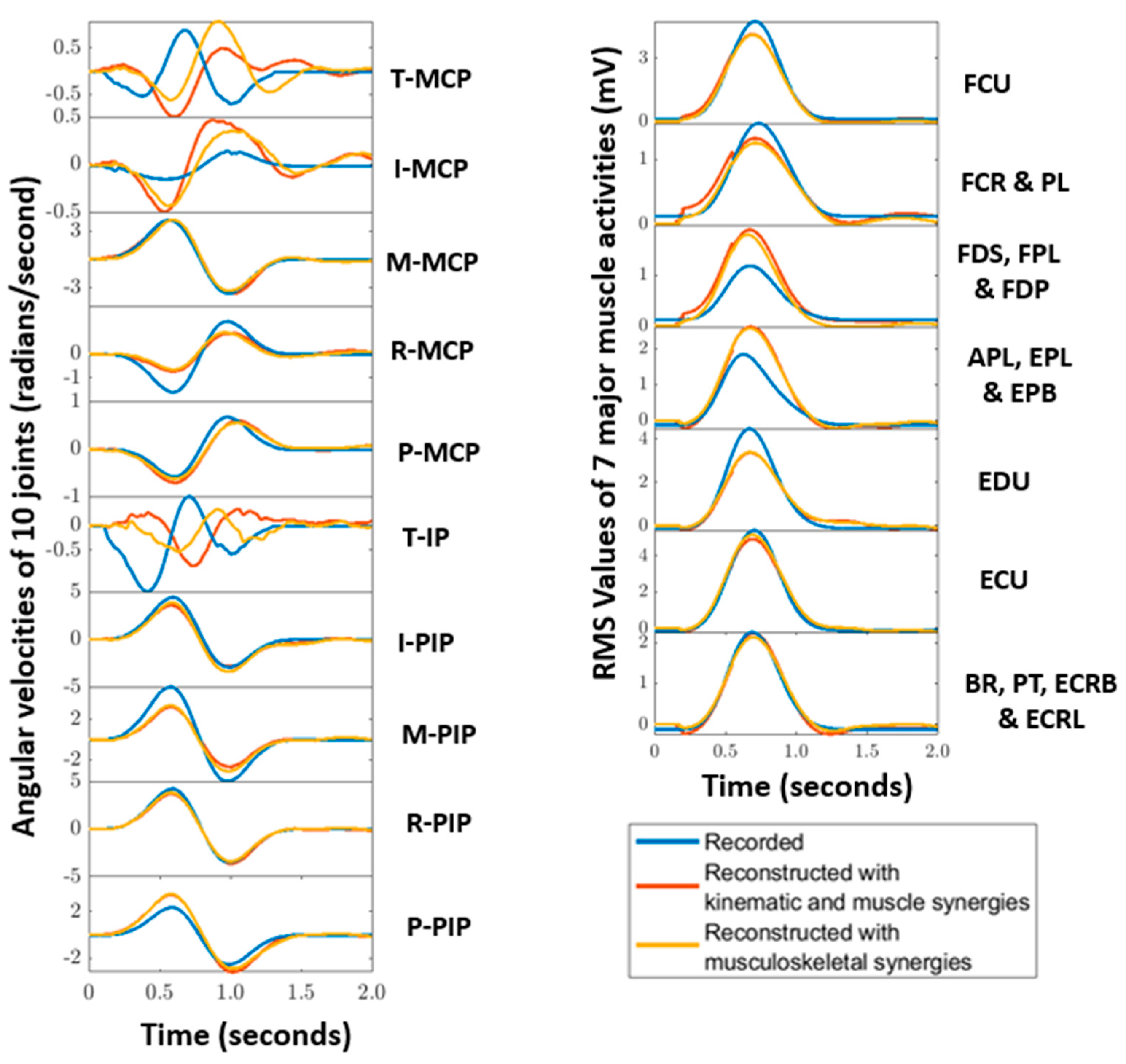
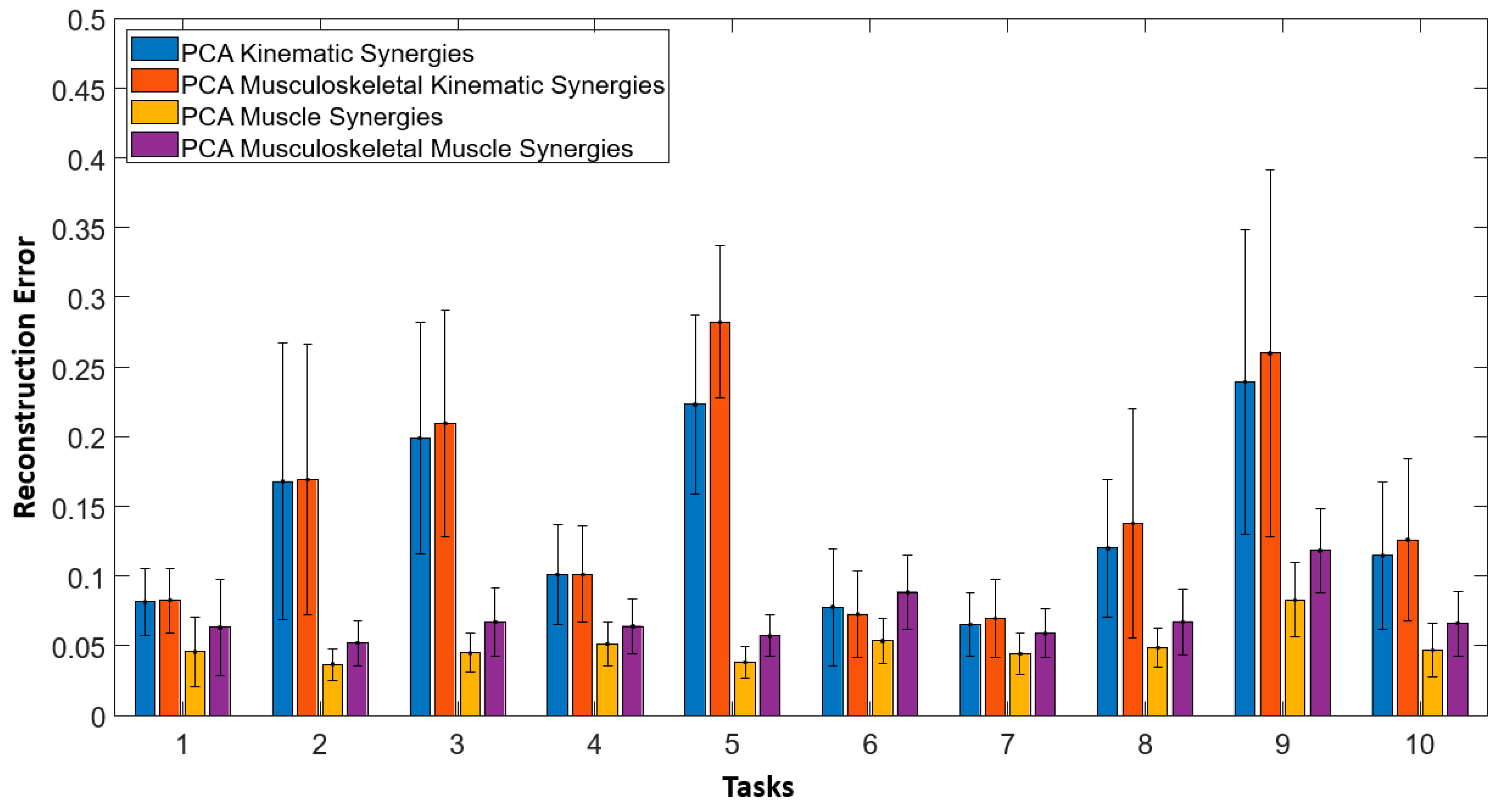

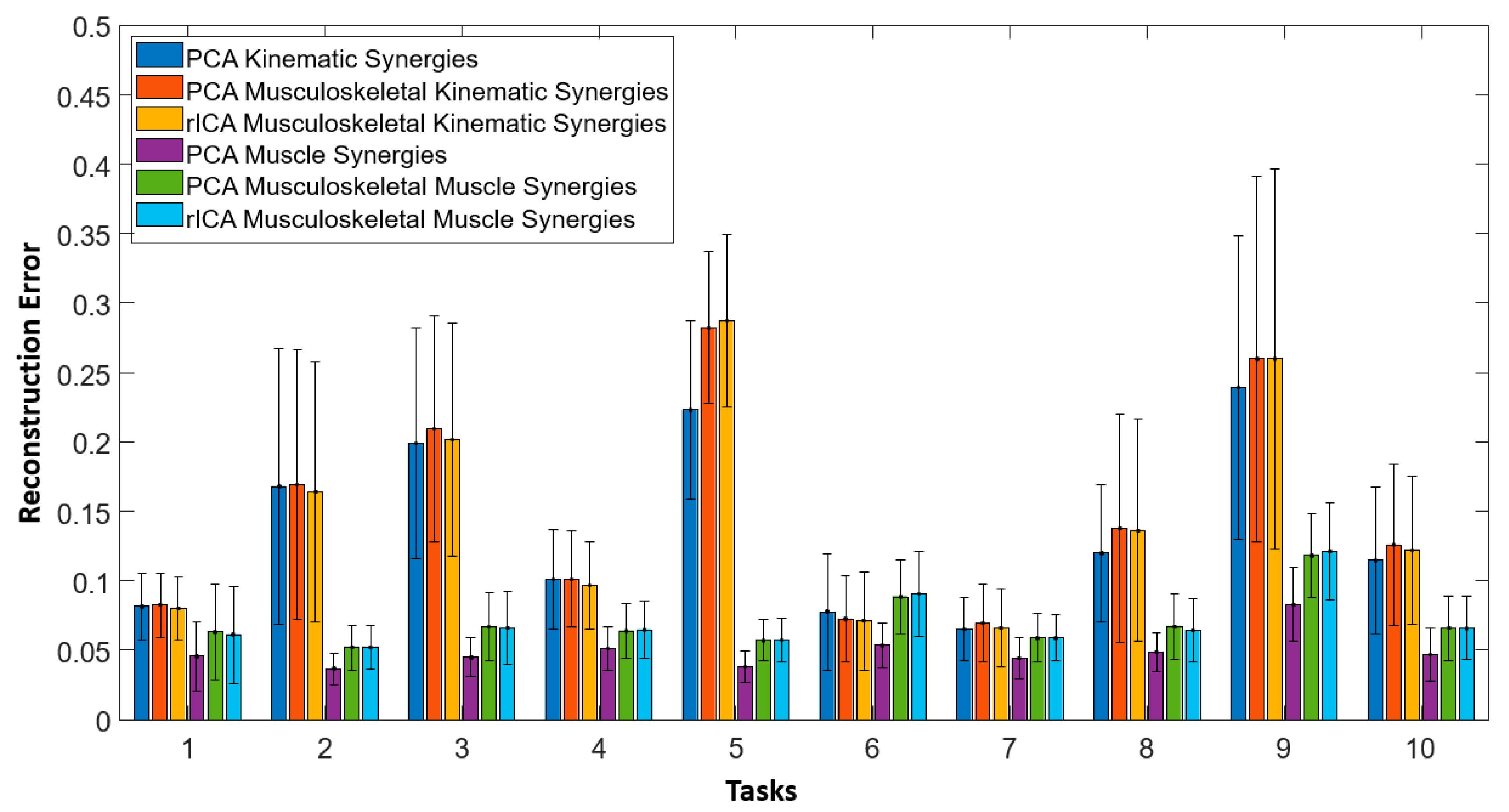
Publisher’s Note: MDPI stays neutral with regard to jurisdictional claims in published maps and institutional affiliations. |
© 2022 by the authors. Licensee MDPI, Basel, Switzerland. This article is an open access article distributed under the terms and conditions of the Creative Commons Attribution (CC BY) license (https://creativecommons.org/licenses/by/4.0/).
Share and Cite
Olikkal, P.; Pei, D.; Adali, T.; Banerjee, N.; Vinjamuri, R. Data Fusion-Based Musculoskeletal Synergies in the Grasping Hand. Sensors 2022, 22, 7417. https://doi.org/10.3390/s22197417
Olikkal P, Pei D, Adali T, Banerjee N, Vinjamuri R. Data Fusion-Based Musculoskeletal Synergies in the Grasping Hand. Sensors. 2022; 22(19):7417. https://doi.org/10.3390/s22197417
Chicago/Turabian StyleOlikkal, Parthan, Dingyi Pei, Tülay Adali, Nilanjan Banerjee, and Ramana Vinjamuri. 2022. "Data Fusion-Based Musculoskeletal Synergies in the Grasping Hand" Sensors 22, no. 19: 7417. https://doi.org/10.3390/s22197417
APA StyleOlikkal, P., Pei, D., Adali, T., Banerjee, N., & Vinjamuri, R. (2022). Data Fusion-Based Musculoskeletal Synergies in the Grasping Hand. Sensors, 22(19), 7417. https://doi.org/10.3390/s22197417










